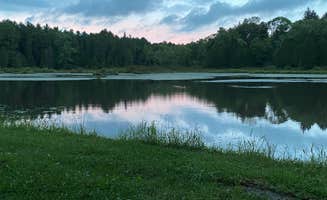Primitive camping near Avon, New York occurs primarily in state forests throughout Livingston and Allegany counties. Seasonal access varies significantly with spring bringing wet terrain and fall offering optimal conditions with minimal insects and moderate temperatures. Winter dispersed camping requires additional preparation as roads may not be plowed and temperatures regularly drop below freezing from December through March.
What to do
Wildlife observation and photography: Several sites at Palmers Pond State Forest offer excellent beaver watching opportunities. "Lots of beavers to watch throughout the day," notes one visitor, while early mornings provide optimal viewing conditions.
Fishing: The pond at Palmers Pond State Forest allows bank fishing with several accessible points. "Has a pond to fish in, by far my most favorite place to camp," reports one regular visitor. No boat launch facilities exist, but small portable craft can be carried in.
Hiking and exploration: Primitive trails wind throughout the forest areas, though seasonal conditions affect accessibility. "Most of the trails are choked with growth or blocked with fallen trees," notes a visitor about Ossian State Forest on Scoville Road, indicating potential navigation challenges.
What campers like
Solitude and quiet settings: The dispersed nature of these sites ensures minimal neighbor noise. "I drove out from Wisconsin and was the only one there. Threw up the tentsile tent overlooking the pond on the south side," shares one camper about their peaceful experience.
Natural camping surfaces: Most sites feature comfortable ground conditions. "Abundant flat and grassy terrain under pines near a beautiful lake," reports a camper about English Hill State Forest, making tent setup easier than in rockier regions.
Low-traffic locations: Even during peak seasons, these areas remain relatively uncrowded. "Some people drove past but not much noise aside from that," mentions a visitor who appreciated the minimal disturbance at their campsite.
Site cleanliness: Despite limited maintenance, many sites remain in good condition. "The site was very nice. Clean and well maintained. I was able to set up next to the water with no problem," notes a recent visitor.
What you should know
Access road conditions: Many sites require navigation on unpaved roads with varying maintenance. "The road was gravel but pretty easy to drive," reports one camper, while others note more challenging conditions requiring higher clearance vehicles.
Navigation challenges: GPS directions frequently lead to inaccessible routes or dead ends. "Google maps directed us to a dead end, go in through the north entrance and you'll be good," advises one camper about Palmer's Pond State Forest.
Site availability varies by season: Conditions change dramatically throughout the year, with spring often bringing flooded or muddy access roads. "The pond was dried up when we got there so that sad kind of a bummer," reports one late-season visitor.
Limited facilities: True primitive camping means complete self-sufficiency. "Dispersed free LNT style, no services," summarizes one camper, highlighting the need to pack all necessary supplies including water and waste disposal equipment.
Tips for camping with families
Site selection for safety: Choose established sites with clear boundaries. "Beautiful grassy spots around the pond and along the road in," notes a camper, with open areas providing better visibility for monitoring children.
Multiple site options: Look beyond obvious lakeside spots if those are taken. "If the lake spots are busy check the woods, there are a bunch more nice spots," advises a camper at Stewart Road Horse Camp.
Pre-trip reconnaissance: Consider scouting locations before bringing the entire family. "The written directions from other reviews were easy to follow," shares a camper who successfully navigated to their site, reducing arrival stress common with family camping.
Water considerations: Pond water levels fluctuate seasonally and may not be suitable for swimming. Families should bring adequate drinking water supplies, as no potable water exists at these locations.
Tips from RVers
Site accessibility: Most dispersed areas accommodate smaller RVs but have limitations. "Lots of camping along the road and around the pond," notes a camper, with roadside pull-offs generally more accessible than pond-adjacent sites.
Levelness varies by location: While some sites offer naturally level parking, most require leveling equipment. Some sites at Ossian State Forest West Camp feature established pads that can accommodate smaller trailers.
Limited turnaround space: Larger rigs may struggle with tight forest roads. Consider scouting ahead without your trailer to ensure adequate space exists for positioning your vehicle.
Self-contained setup required: No hookups, dump stations, or water fill locations exist at these sites, requiring complete boondocking capability and appropriate waste management plans.


